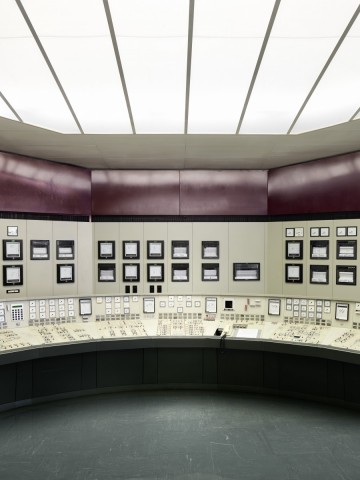Scanderbeg Sauer
CHAVALON
October 26, 2011 – October 8, 2011
Following their highly successful ‘Decommissioned’ exhibition, SCANDERBEG SAUER aim now their lens at out-of-use industrial plants. While aeroplanes such as those portrayed in ‘Decommissioned’ can be removed from service without too much trouble, the removal from operation of larger and primarily housed machine installations is slightly more complicated.
The history of Chavalon is only marginally relevant when wishing to understand SCANDERBEG SAUER’s series of images. Chavalon is exemplary of many other industrial plants. Economic and political decisions of national importance are primarily mirrored in such large-scale projects; these projects later allow an insight into the prevalent opinions of the time.
Chavalon was built on a terrace high above the Rhone valley. It began operating in 1965 and went out of service in 1999. Heated with crude oil, this power station was constructed in such an unusual place so as to avoid emissions lingering in the valley. Visible from some distance, the plant consists of a 120 metre high chimney, the actual power station building and four cooling towers. Purpose-built dwellings were erected close to the power station in order to house some of its employees. When the plant went out of service, plans were drawn up to develop a gas power station on the same site. Due to new environmental laws and submitted objections, however, the plant now remains in an unaltered state.
So what attracted SCANDERBEG SAUER to Chavalon? One reason was the plant’s loss of cool, technological supremacy, a morbid aesthetic being its only emission today. Scattered files and tools or dusty machine parts reveal the vulnerability and the finite nature of this once modern technology. With their accomplished, distanced view SCANDERBEG SAUER have once again created powerfully silent images that act not as a documentation, but capture the inner state of this plant like a portrait.
They have managed to get to the organs of this power station in a minimum of images to create iconic references: the combustion chamber, the heart of the power station, reminds one of a cathedral, the control centre looks like the command bridge of a spacecraft and the work rooms with their mountains of files have the feel of quickly abandoned Secret Service offices. The sensitive portraits of the plant’s former employees are seamlessly integrated into this series. ‘Chavalon’ presents a conscious view of the ambiguity of a nationally important project admidst global and political changes.
The history of Chavalon is only marginally relevant when wishing to understand SCANDERBEG SAUER’s series of images. Chavalon is exemplary of many other industrial plants. Economic and political decisions of national importance are primarily mirrored in such large-scale projects; these projects later allow an insight into the prevalent opinions of the time.
Chavalon was built on a terrace high above the Rhone valley. It began operating in 1965 and went out of service in 1999. Heated with crude oil, this power station was constructed in such an unusual place so as to avoid emissions lingering in the valley. Visible from some distance, the plant consists of a 120 metre high chimney, the actual power station building and four cooling towers. Purpose-built dwellings were erected close to the power station in order to house some of its employees. When the plant went out of service, plans were drawn up to develop a gas power station on the same site. Due to new environmental laws and submitted objections, however, the plant now remains in an unaltered state.
So what attracted SCANDERBEG SAUER to Chavalon? One reason was the plant’s loss of cool, technological supremacy, a morbid aesthetic being its only emission today. Scattered files and tools or dusty machine parts reveal the vulnerability and the finite nature of this once modern technology. With their accomplished, distanced view SCANDERBEG SAUER have once again created powerfully silent images that act not as a documentation, but capture the inner state of this plant like a portrait.
They have managed to get to the organs of this power station in a minimum of images to create iconic references: the combustion chamber, the heart of the power station, reminds one of a cathedral, the control centre looks like the command bridge of a spacecraft and the work rooms with their mountains of files have the feel of quickly abandoned Secret Service offices. The sensitive portraits of the plant’s former employees are seamlessly integrated into this series. ‘Chavalon’ presents a conscious view of the ambiguity of a nationally important project admidst global and political changes.

